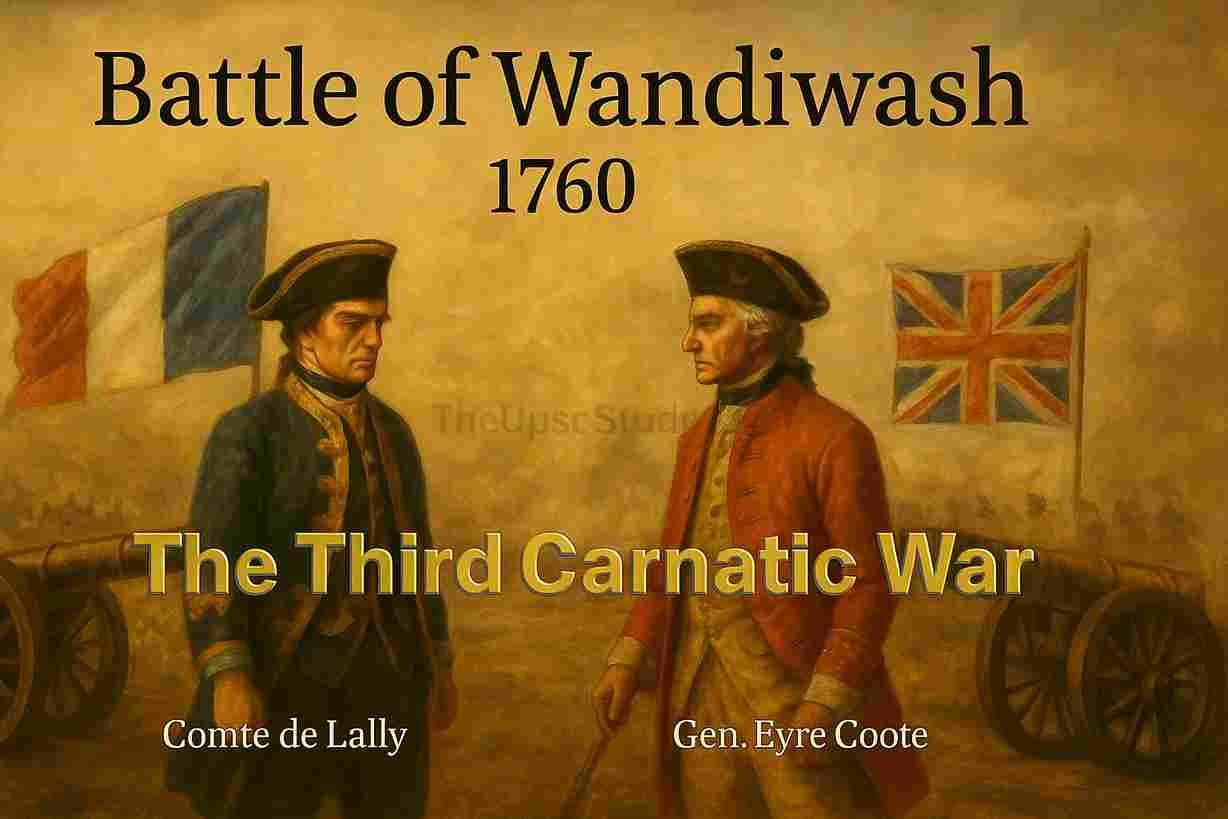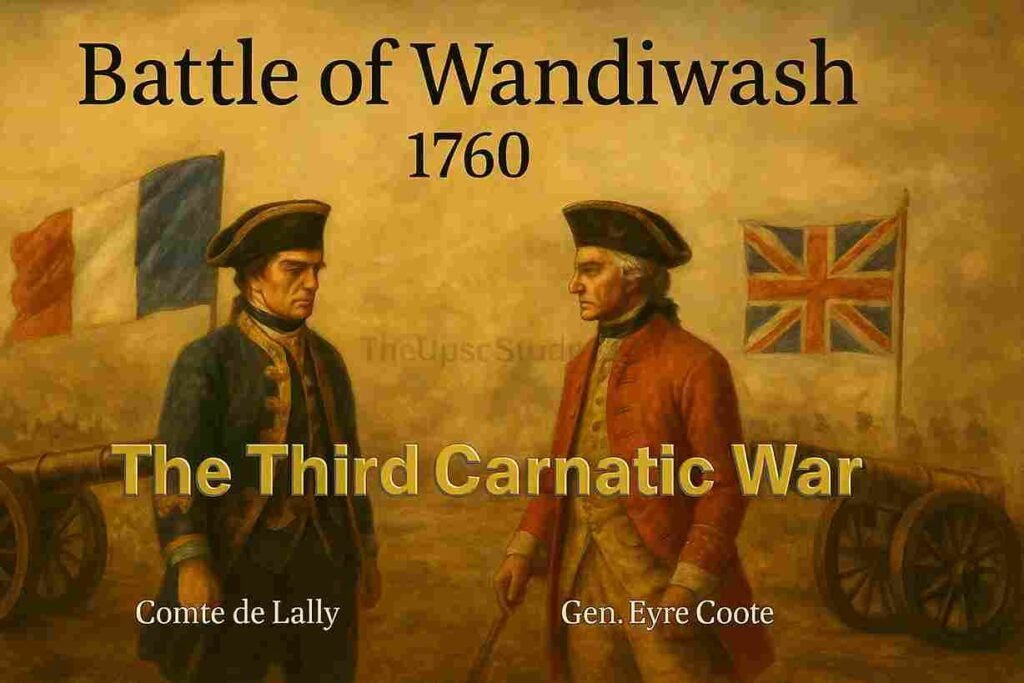Third Carnatic War (1756-63): Final battle between two Colonial powers.
Table of Contents
Third Carnatic War- In brief
Following the two Carnatic Wars, the Third Carnatic War was directly linked to the outbreak of the Seven Years’ War (1756–1763) in Europe, which spread to the Americas and Asia, mainly between the British and the French kingdoms. The impact first initiated in the conflict in the Madras and Pondicherry settlements of English and French, respectively, that progressed further to expansion to Bengal by Robert Clive, leading to the Battle of Plassey and Battle of Wandiwash which concluded in the Treaty of Paris.
The Seven Years’ War (1756–1763)
It was a global conflict fought between major European powers, primarily Britain and Prussia against France, Austria, Russia, and Spain. It is often called the first “world war”, as battles occurred in Europe, North America (French and Indian American War), the Caribbean, West Africa, and India- Carnatic war. The war ended with the Treaty of Paris (1763), marking Britain’s rise as the leading colonial power, while France lost most of its overseas territories.
Expansion to Bengal
- In Bengal, the conflict was triggered by the fortification of Chandannagore by the French and the strengthening of Fort William by the English East India Company.
- This confrontation led to the Battle of Plassey (23 June 1757), which extended the Anglo-French rivalry beyond southern India into Bengal.
- During the campaign:
- The British forces captured the French settlement at Chandannagore in 1757.
- They also reclaimed Fort William from the Bengal Nawab, Siraj-ud-Daulah.
Siraj-ud-Daulah’s Role
- Siraj-ud-Daulah (1756–1757) was the grandson of Alivardi Khan, the Nawab of Bengal, Bihar and Orissa (and Nawab of Bengal and Bihar after the surrendering Orissa to Marathas in 1751), which combinedly called Bengal Subah.
- He ascended the throne at Murshidabad after a contested succession against Shaukat Jung (Nawab of Purnia and another grandson of Aliverdi) and his aunt Ghasiti Begum (daughter of Alivardi Khan).
- Siraj was known for his youthful courage and was even praised in Siyar-ul-Mutakhkherin by Gulam Husain Tabatabai, who narrated the Indian perspective of the Battle of Plassey.
Key Events of the Third Carnatic War
- The Black Hole Incident (20 June 1756) in Calcutta, where English prisoners were allegedly suffocated in a small dungeon, was one of the immediate causes of the conflict.
- The Treaty of Alinagar (9 February 1757) was signed between Siraj-ud-Daulah and the East India Company, temporarily restoring Company privileges.
- Later that year, Robert Clive led the Company forces to victory in the Battle of Plassey, defeating Siraj-ud-Daulah with the help of traitors like Mir Jafar.
- Concluded in the Battle of Wandiwash.
Battle of Wandiwash (1760)
- The decisive battle of the Third Carnatic War was fought at Wandiwash (Vandavasi, Tamil Nadu) on 22 January,,1760.
- The French army, commanded by French governor general of India-Comte de Lally, faced the British forces under General Eyre Coote.
- The British achieved a decisive victory, which broke French military strength in India.
Fall of French Settlements
- Following Wandiwash, the French lost their key stronghold of Pondicherry, which was captured by the British in 1761.
- This effectively ended French territorial ambitions in India.
Conclusion
Treaty of Paris (1763)
- The Third Carnatic War concluded with the Treaty of Paris (1763), on 10 February 1763, which settled the Seven Years’ War globally.
- In India:
- Chandannagore and Pondicherry were restored to the French.
- The French were allowed to continue trading, but were strictly forbidden from taking part in political or administrative affairs in India.
The Black Hole Tragedy of Calcutta (1756)
In June 1756, tensions escalated between the East India Company (EIC) and the Nawab of Bengal, Siraj-ud-Daulah. The Nawab strongly opposed the fortification of Fort William by the Company at Calcutta, as well as the French fortifying Chandannagore. While the French complied with his order to stop fortifications, the British resisted.
Capture of Fort William
- In response, Siraj-ud-Daulah attacked and captured the old Fort William (built between 1698–1703, located at present-day Hastings, Kolkata).
- Many English soldiers and civilians were taken prisoner. This incident came to be known as the Black Hole Tragedy of Calcutta (20 June 1756).
The Black Hole Incident
- According to British accounts, John Zephaniah Holwell, a Company officer, led a hasty civilian defense but eventually surrendered.
- Around 146 prisoners (including English soldiers and Indian sepoys) were confined overnight in a tiny guardroom measuring only 14 by 18 feet, with no ventilation.
- By the next morning, only 23 prisoners survived, including Holwell, while the rest had suffocated.
- However, Indian historian Ghulam Hussain Tabatabai, in his Siyar-ul-Mutakhkherin (a contemporary account of the Battle of Plassey), did not mention this tragedy, suggesting it might have been exaggerated or part of a British narrative.
Aftermath
- Following the incident, the British constructed the new Fort William at the Maidan area of Calcutta.
- The tragedy fueled anti-Nawab sentiment among the British and became one of the key justifications for the Battle of Plassey (1757).
Towards the Battle of Plassey
- Robert Clive used the incident as a rallying cry to seek vengeance against Siraj-ud-Daulah.
- Secret negotiations were opened with Mir Jafar (Commander of Nawab’s army), Jagat Seth (banker), Omichand and Manickchand, who together promised financial rewards worth £1 million (approx. ₹33 million today) to English officers, if the British helped overthrow the Nawab.
- Even Ghasiti Begum, Siraj’s aunt, supported this conspiracy against him.
Treaty of Alinagar (1757)
- Before the Battle of Plassey, the Treaty of Alinagar was signed between Siraj-ud-Daulah and the Company on 9 February, 1757.
- Calcutta, which Siraj had renamed Alinagar after capturing it in 1756, was restored to the Company.
- The treaty temporarily granted back the Company’s trade privileges, the Farman of 1717 by FarookSiyar, but set the stage for Clive’s decisive confrontation with Siraj at Plassey.
The Battle of Plassey (1757)
Background
Following the Black Hole Tragedy of Calcutta (1756), Robert Clive, then stationed at Fort St. George, Madras, resolved to recapture Fort William and overthrow the Nawab of Bengal, Siraj-ud-Daulah. Clive sent Eyre Coote to lead the British forces in reclaiming Fort William. Though the Treaty of Alinagar (1757) was signed, Siraj soon violated its terms, prompting the Company to prepare for direct confrontation.
Forces Involved
- East India Company (circa 3,100 troops)
- Secured the support of key conspirators:
- Mir Jafar – Commander of Nawab’s army, secretly allied with Clive.
- Jagat Seth – Powerful banker, promised Clive financial support of £1 million.
- Omichand – Wealthy merchant involved in negotiations.
- Ghasiti Begum (Siraj’s aunt) and Shaukat Jang (Nawab of Purnia), both opposed Siraj.
- Raja Krishnachandra of Nadia also supported the English.
- Manik Chand, an officer of Siraj, defected to the British.
- Secured the support of key conspirators:
- Nawab’s Army (circa 50,000 troops)
- Included a French contingent under Monsieur St. Frais.
- Loyal commanders were Mir Madan and Mohan Lal, who fought bravely alongside Siraj.
Course of the Battle
The battle was fought at Plassey (Palashi) on 23 June 1757. Despite the Nawab’s numerical superiority, treachery determined the outcome:
- Most of Siraj’s commanders, led by Mir Jafar, betrayed him by withholding their troops from action.
- Only Mir Madan and Mohan Lal remained loyal, but Mir Madan was killed in battle.
- The betrayal left Siraj isolated and demoralized.
- The English secured an easy victory; the event is often described as more a conspiracy than a true battle.
Aftermath and Significance
- Siraj-ud-Daulah fled but was later captured and executed.
- The victory at Plassey marked a turning point in Indian history, often referred to as the “Plassey Plunder”, since it enriched the Company enormously.
- The English, who had come as traders, now began transforming into a political and colonial power.
Installation of Mir Jafar
- Mir Jafar (1757–1760) was installed as a puppet Nawab by Robert Clive.
- He met the demands of the Company, granting them lavish sums of money and land.
- Under him, the infamous “Drain of Wealth” from Bengal began.
- He gifted Clive the revenues of 24 Parganas, further strengthening British influence.
Rising Tensions and the Battle of Chinsurah (1759)
- The British made exorbitant demands, which alarmed Mir Jafar.
- Seeking to reduce British dominance, he sought the support of the Dutch East India Company, who had a base at Chinsurah.
- This led to the Battle of Chinsurah (1759) between the English and the Dutch.
- The East India Company decisively defeated the Dutch, eliminating them as a significant rival in Bengal.


